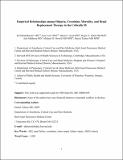| dc.contributor.author | Mandelbaum, Tal | |
| dc.contributor.author | Lee, Joon | |
| dc.contributor.author | Scott, Daniel J. | |
| dc.contributor.author | Mark, Roger Greenwood | |
| dc.contributor.author | Malhotra, Atul | |
| dc.contributor.author | Howell, Michael D. | |
| dc.contributor.author | Talmor, Daniel | |
| dc.date.accessioned | 2013-01-24T17:49:02Z | |
| dc.date.available | 2013-01-24T17:49:02Z | |
| dc.date.issued | 2012-12 | |
| dc.date.submitted | 2012-05 | |
| dc.identifier.issn | 0342-4642 | |
| dc.identifier.issn | 1432-1238 | |
| dc.identifier.uri | http://hdl.handle.net/1721.1/76596 | |
| dc.description.abstract | Purpose: The observation periods and thresholds of serum creatinine and urine output defined in the Acute Kidney Injury Network (AKIN) criteria were not empirically derived. By continuously varying creatinine/urine output thresholds as well as the observation period, we sought to investigate the empirical relationships among creatinine, oliguria, in-hospital mortality, and receipt of renal replacement therapy (RRT).
Methods: Using a high-resolution database (Multiparameter Intelligent Monitoring in Intensive Care II), we extracted data from 17,227 critically ill patients with an in-hospital mortality rate of 10.9 %. The 14,526 patients had urine output measurements. Various combinations of creatinine/urine output thresholds and observation periods were investigated by building multivariate logistic regression models for in-hospital mortality and RRT predictions. For creatinine, both absolute and percentage increases were analyzed. To visualize the dependence of adjusted mortality and RRT rate on creatinine, the urine output, and the observation period, we generated contour plots.
Results: Mortality risk was high when absolute creatinine increase was high regardless of the observation period, when percentage creatinine increase was high and the observation period was long, and when oliguria was sustained for a long period of time. Similar contour patterns emerged for RRT. The variability in predictive accuracy was small across different combinations of thresholds and observation periods.
Conclusions: The contour plots presented in this article complement the AKIN definition. A multi-center study should confirm the universal validity of the results presented in this article | en_US |
| dc.description.sponsorship | National Institute of Biomedical Imaging and Bioengineering (U.S.) (Grant R01 EB001659) | en_US |
| dc.language.iso | en_US | |
| dc.publisher | Springer-Verlag | en_US |
| dc.relation.isversionof | http://dx.doi.org/10.1007/s00134-012-2767-x | en_US |
| dc.rights | Creative Commons Attribution-Noncommercial-Share Alike 3.0 | en_US |
| dc.rights.uri | http://creativecommons.org/licenses/by-nc-sa/3.0/ | en_US |
| dc.source | Mark via Courtney Crummett | en_US |
| dc.title | Empirical relationships among oliguria, creatinine, mortality, and renal replacement therapy in the critically ill | en_US |
| dc.type | Article | en_US |
| dc.identifier.citation | Mandelbaum, Tal et al. “Empirical Relationships Among Oliguria, Creatinine, Mortality, and Renal Replacement Therapy in the Critically Ill.” Intensive Care Medicine (2012). | en_US |
| dc.contributor.department | Harvard University--MIT Division of Health Sciences and Technology | en_US |
| dc.contributor.department | Massachusetts Institute of Technology. School of Engineering | en_US |
| dc.contributor.approver | Mark, Roger Greenwood | |
| dc.contributor.mitauthor | Mandelbaum, Tal | |
| dc.contributor.mitauthor | Lee, Joon | |
| dc.contributor.mitauthor | Scott, Daniel J. | |
| dc.contributor.mitauthor | Mark, Roger Greenwood | |
| dc.relation.journal | Intensive Care Medicine | en_US |
| dc.eprint.version | Author's final manuscript | en_US |
| dc.type.uri | http://purl.org/eprint/type/JournalArticle | en_US |
| eprint.status | http://purl.org/eprint/status/PeerReviewed | en_US |
| dspace.orderedauthors | Mandelbaum, Tal; Lee, Joon; Scott, Daniel J.; Mark, Roger G.; Malhotra, Atul; Howell, Michael D.; Talmor, Daniel | en |
| dc.identifier.orcid | https://orcid.org/0000-0001-8593-9321 | |
| dc.identifier.orcid | https://orcid.org/0000-0002-6318-2978 | |
| mit.license | OPEN_ACCESS_POLICY | en_US |
| mit.metadata.status | Complete | |
